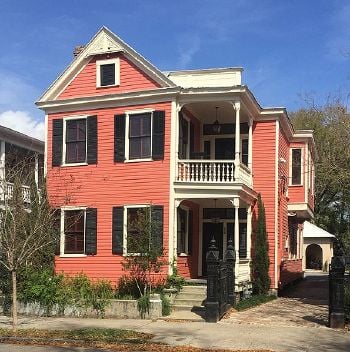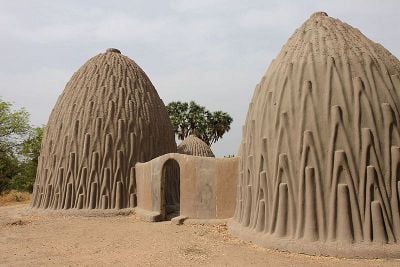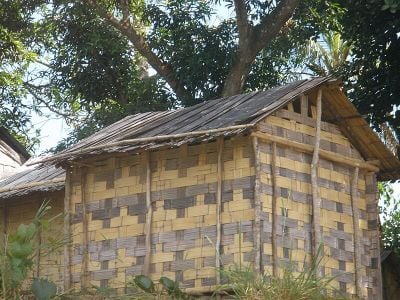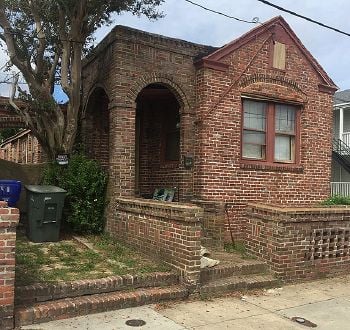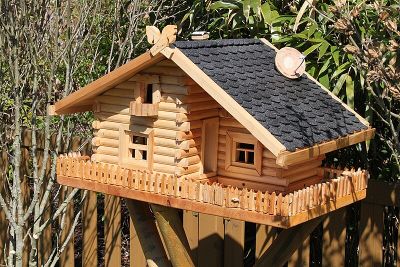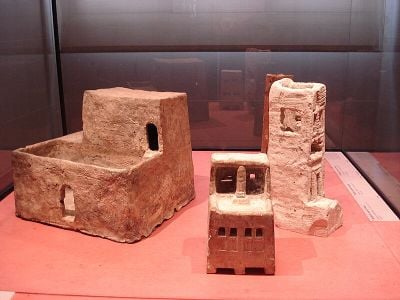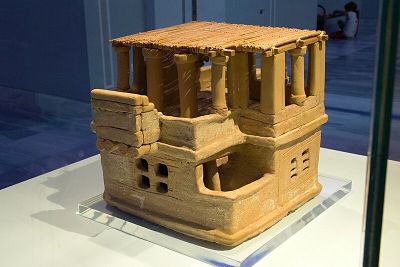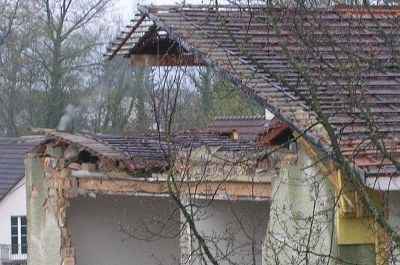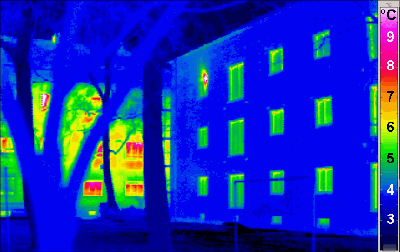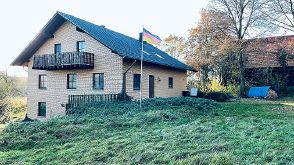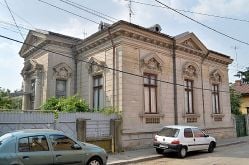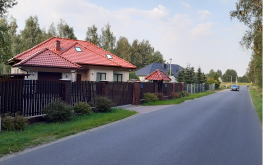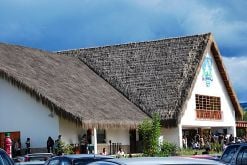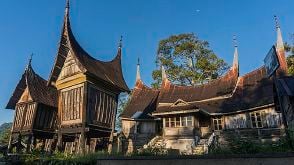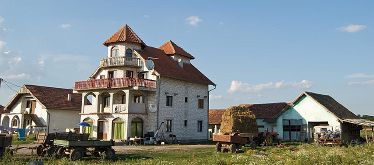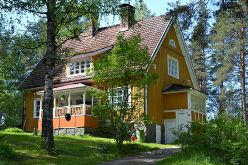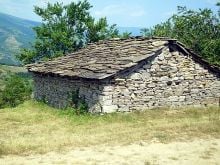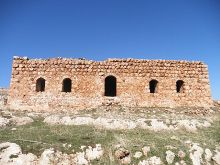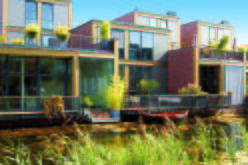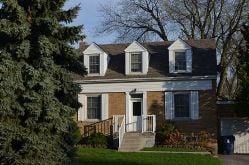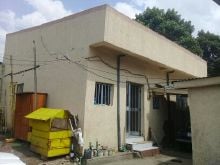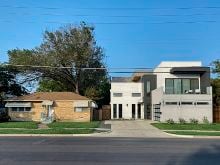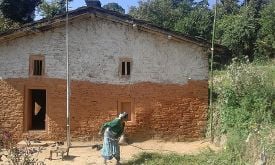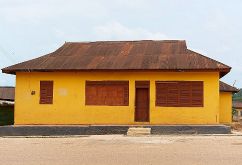House
This article is about the building used as a dwelling place
A house is a single-unit residential building. It may range in complexity from a rudimentary hut to a complex structure of wood, masonry, concrete or other material, outfitted with plumbing, electrical, and heating, ventilation, and air conditioning systems. Most conventional modern houses in Western cultures will contain one or more bedrooms and bathrooms, a kitchen or cooking area, and a living room. A house may have a separate dining room, or the eating area may be integrated into another room. Some large houses in North America have a recreation room. In traditional agriculture-oriented societies, domestic animals such as chickens or larger livestock (like cattle) may share part of the house.
The social unit that lives in a house is known as a household, most commonly a family unit of some kind, although households may also be other social groups, such as roommates. Some houses only have a dwelling space for one family or similar-sized group; larger houses may contain numerous family dwellings in the same structure.
Etymology
The English word house derives directly from the Old English word hus, meaning "dwelling, shelter, home, house," which in turn derives from Proto-Germanic husan (reconstructed by etymological analysis) which is of unknown origin.[1]
The term house itself gave rise to the letter 'B' through an early Proto-Semitic hieroglyphic symbol depicting a house. The symbol was called "bayt", "bet" or "beth" in various related languages, and became beta, the Greek letter, before it was used by the Romans.[2]
Definitions
A house is a single-unit residential building. It may range in complexity from a rudimentary hut to a complex structure of wood, masonry, concrete, or other material, outfitted with plumbing, electrical, and heating, ventilation, and air conditioning systems.[3]
The social unit that lives in a house is known as a household. Most commonly, a household is a family unit of some kind, although households may also be other social groups, such as roommates or, in a rooming house, unconnected individuals, that typically use that house as their home.
Elements
Houses use a range of different roofing systems to keep precipitation (rain or snow) from getting into the dwelling space. Houses may have doors or locks to secure the dwelling space and protect its inhabitants and contents from burglars or other trespassers.
Layout
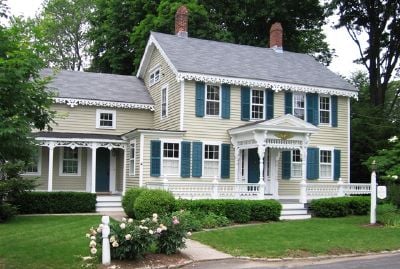
Ideally, architects of houses design rooms to meet the needs of the people who will live in the house. Some houses only have a dwelling space for one family or similar-sized group; larger houses called townhouses or row houses may contain numerous family dwellings in the same structure. Houses may consist of a single floor or level of living space, or several floors. Multi-story buildings where three or more residences are contained within one structure are known as apartment buildings, blocks of flats, or tenements.
A house may be accompanied by outbuildings, such as a garage for vehicles or a shed for gardening equipment and tools. A house may have a backyard or a front yard or both, which serve as additional areas where inhabitants can relax or eat.
Humans often build houses for domestic or wild animals, often resembling smaller versions of human domiciles. Familiar animal houses built by humans include birdhouses, hen houses and dog houses, while housed agricultural animals more often live in barns and stables.
Parts
Many houses have several large rooms with specialized functions and several very small rooms for other uses. These may include a living/eating area, a sleeping area, and (if suitable facilities and services exist) separate or combined washing and toilet areas. Some larger properties may also feature specialized rooms such as a laundry room, home office, recreation room, sunroom, or "non-essential" facilities such as a spa room, indoor pool, or indoor basketball court. Most conventional modern houses in Western cultures will contain one or more bedrooms and bathrooms, a kitchen or cooking area, and a living room. A house may have a separate dining room, or the eating area may be integrated into another room.
In traditional agriculture-oriented societies, domestic animals such as chickens or larger livestock often share part of the house with humans.
The names of parts of a house often echo the names of parts of other buildings, but could typically include:
- Alcove
- Atrium
- Attic
- Basement/cellar
- Bathroom
- Bedroom (or nursery)
- Box-room / storage room
- Conservatory
- Dining room
- Family room or den
- Fireplace
- Foyer
- Front room
- Garage
- Hallway / passage / Vestibule
- Hearth
- Home-office or study
- Kitchen
- Larder
- Laundry room
- Library
- Living room
- Loft
- Nook
- Pantry
- Parlour
- Porch
- Recreation room / rumpus room / television room
- Shrines to serve the religious functions associated with a family
- Stairwell
- Sunroom
- Swimming pool
- Window
- Workshop
History
Little is known about the earliest origin of the house and its interior; however, it can be traced back to the simplest form of shelters. For example, an exceptionally well-preserved house dating to the fifth millennium B.C.E. and with its contents still preserved was excavated at Tell Madhur in Iraq.[4]
Roman architect Vitruvius claimed the first form of architecture as a frame of timber branches finished in mud, also known as the primitive hut.[5]
Middle Ages
In the Middle Ages, the Manor houses facilitated different activities and events. Furthermore, the houses accommodated numerous people, including the Lord of the Manor and his family, as well as servants and guests. Their lifestyles were largely communal, as areas such as the Great Hall, the main meeting and dining area used by everyone who lived in the Manor House, and the Solar intended for shared sleeping beds.[6]
During the fifteenth and sixteenth centuries, the Italian Renaissance palazzo consisted of plentiful rooms of connectivity. Unlike the qualities and uses of the Manor Houses, most rooms of the palazzo contained no purpose, yet were given several doors, creating a "matrix of discrete but thoroughly interconnected chambers."[7] The layout allowed occupants to freely walk room to room from one door to another, thus breaking the boundaries of privacy and encouraging social interaction among the inhabitants:
Once inside it is necessary to pass from one room to the next, then to the next to traverse the building. Where passages and staircases are used, as inevitably they are, they nearly always connect just one space to another and never serve as general distributors of movement. Thus, despite the precise architectural containment offered by the addition of room upon room, the villa was, in terms of occupation, an open plan, relatively permeable to the numerous members of the household.[7]
An early example of the segregation of rooms and consequent enhancement of privacy may be found in 1597 at the Beaufort House built in Chelsea, London. The separation of the passageway from the room developed the function of the corridor. This new extension was revolutionary at the time, allowing the integration of one door per room, in which all universally connected to the same corridor. In this way, rooms were changed from public to private as single entryways forced notions of entering a room with a specific purpose. This was designed by English architect John Thorpe, who wrote on his plans, "A Long Entry through all."[8]
Architect Sir Roger Pratt commented on the design that:
"the common way in the middle through the whole length of the house" was to prevent "the offices from one molesting the other by continual passing through them" and in the rest of the house, to ensure that "ordinary servants may never publicly appear in passing to and fro for their occasions there."[7]
This social divide, keeping the servants out of the way of the wealthy, favored the physical integration of the corridor into housing by the nineteenth century. Sociologist Witold Rybczynski wrote, "the subdivision of the house into day and night uses, and into formal and informal areas, had begun."[9]
Industrial Revolution
Compared to the large scaled houses in England and the Renaissance, the seventeenth Century Dutch house was smaller, and was inhabited by up to four to five members. This was because they embraced "self-reliance"[5] in contrast to dependence on servants, and a design for a lifestyle centered on the family. It was important for the Dutch to separate work from domesticity, as the home became an escape and a place of comfort:
As far as the idea of the home is concerned, the home of the home is the Netherlands. This idea's crystallization might be dated to the first three-quarters of the 17th century, when the Dutch Netherlands amassed the unprecedented and unrivalled accumulation of capital, and emptied their purses into domestic space.[5]
By the end of the seventeenth century, the house layout had been transformed to become employment-free. This came in favor during the Industrial Revolution, gaining large-scale factory production and workers.[5] This way of living and house layout are still relevant today, highly similar to the contemporary family and their dwellings.
Nineteenth and twentieth centuries
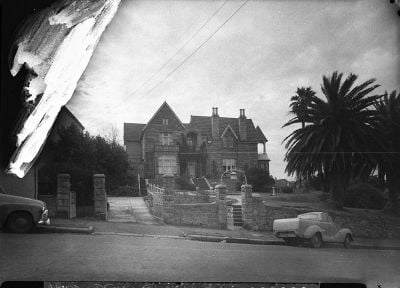
In the nineteenth and early twentieth century some professions, such as doctors, typically operated out of the front room or parlor or had a two-room office on their property, which was detached from the house. By the mid-twentieth century, the increase in high-tech equipment created a marked shift whereby the contemporary doctor typically worked from an office or hospital.[10]
Technology and electronic systems have caused privacy issues, as well as challenges to segregating personal life from remote work. Although commuting to work has been reduced, the desire to separate working and living remains apparent.[5] Still, some architects have designed homes in which eating, working, and living are brought together, bringing back the set-up common in the early twentieth century.
Construction
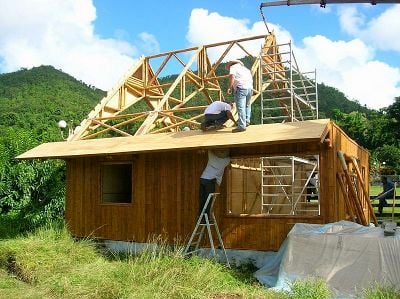
Generally, people often build houses out of the nearest available material, and often tradition or culture govern construction-materials, so whole towns, areas, counties or even states/countries may be built out of one main type of material. For example, a large portion of American houses use wood, while most British and many European houses use stone, brick, or mud.
In many parts of the world, houses are constructed using scavenged materials. For example, in Dakar, it is common to see houses made of recycled materials standing atop a mixture of garbage and sand which serves as a foundation. The garbage-sand mixture is also used to protect the house from flooding.[11]
In the United States, modern house construction techniques include light-frame construction (in areas with access to supplies of wood) and adobe or sometimes rammed-earth construction (in arid regions with scarce wood-resources). Some areas use brick almost exclusively, and quarried stone has long provided foundations and walls. To some extent, aluminum and steel have displaced some traditional building materials. Increasingly popular alternative construction materials include insulating concrete forms (foam forms filled with concrete), structural insulated panels (foam panels faced with oriented strand board or fiber cement), light-gauge steel, and steel framing.
In the early twentieth century, some house designers started using prefabrication. First small inside rooms, then later, whole walls were prefabricated and carried to the construction site. More recently, builders have begun to collaborate with structural engineers who use finite element analysis to design prefabricated steel-framed homes with known resistance to high wind loads and seismic forces. These newer products provide labor savings, more consistent quality, and possibly accelerated construction processes.
In the developed world, energy-conservation has grown in importance in house design. Development of a number of low-energy building types and techniques includes the zero-energy house, the passive solar house, the autonomous buildings, the super insulated houses, and houses built to the Passivhaus standard.
Lesser-used construction methods have gained (or regained) popularity in recent years. Though not in wide use, these methods frequently appeal to homeowners who may become actively involved in the construction process. They include:
- Hempcrete construction
- Cordwood construction
- Geodesic domes
- Straw-bale construction
- Wattle and daub
- Timber framing
- Framing (construction)
Identification and Symbolism
With the growth of dense settlement, people designed ways of identifying houses and parcels of land. Individual houses were given names, such as "Morton House," "Mill Cottage," or "The Willows." These were often historically based on the family name, location, or architectural feature. In societies where most relations were based on personal acquaintances, the name of the inhabitant and approximate location of the building were sufficient. Later, a more systematic and general approach to identifying houses, using house numbering was developed.[12]
Houses of particular historical significance (former residences of the famous, for example, or even just very old houses) may gain a protected status in town planning as examples of built heritage or of streetscape. Buildings with historical importance have legal restrictions on changes that can be made as well as protecting them from demolition. Commemorative plaques may mark such structures.
Gallery
Modern land house in Germany
The Belle Époque Ion Popescu House from Ploiești, Romania
Modern suburban house in Poland
Standard montevidean houses in Uruguay
Farmhouse in Bhutan
Khmer house in Cambodia
Traditional house in Colombia
Minangkabau traditional Rumah gadang house in Indonesia
Traditional houses in Faza, Kenya
Traditional village house in Banaue, Philippines
House in Brgule, Serbia
A traditional Finnish house from the beginning of twentieth century in Jyväskylä
Traditional house in Japan
Traditional two-story tin shed house in Bangladesh
Energy-efficient houses in Amersfoort, Netherlands
A house in Ontario, Canada
A decorated house in Utrecht, Netherlands
A single living house in Addis Ababa, Ethiopia
Old and new houses side by side in Dallas, Texas
Traditional house in Darchula District Nepal
A standard house in Ghana
Notes
- ↑ Douglas Harper, house (n.) Online Etymology Dictionary. Retrieved June 27, 2024.
- ↑ David Sacks, Letter Perfect: The marvelous history of our alphabet from A to Z (Crown, 2004, ISBN 978-0767911733).
- ↑ Norbert Schoenauer, 6,000 Years of Housing (W. W. Norton & Company, 2003, ISBN 0393731200).
- ↑ John Curtis, Fifty Years of Mesopotamian Discovery (British Institute for the Study of Iraq, 1982, ISBN 978-0903472050).
- ↑ 5.0 5.1 5.2 5.3 5.4 Jonathan Hill, Immaterial Architecture (New York: Routledge, 2006, ISBN 978-0415363242).
- ↑ Manor House The Middle Ages. Retrieved June 27, 2024.
- ↑ 7.0 7.1 7.2 Robin Evans, Translations from Drawing to Building and Other Essays (London: Architectural Associations Publications, 2023, ISBN 978-1907896972).
- ↑ John Summerson, The Book of Architecture of John Thorpe in Sir John Soane's Museum (The Walpole Society, 1964).
- ↑ Witold Rybczynski, Home: A Short History of an Idea (Penguin Books, 1987, ISBN 0140102310).
- ↑ Doctor’s and Dentist’s Offices Melnick Medical Museum. Retrieved June 27, 2024.
- ↑ Adam Nossiter, In Senegal, Building on Perilous Layers of Trash The New York Times (May 2, 2009). Retrieved June 27, 2024.
- ↑ Anton Tantner, House Numbers: Pictures of a Forgotten History (Reaktion Books, 2015, ISBN 978-1780235189).
ReferencesISBN links support NWE through referral fees
- Curtis, John. Fifty Years of Mesopotamian Discovery. British Institute for the Study of Iraq, 1982. ISBN 978-0903472050
- Evans, Robin. Translations from Drawing to Building and Other Essays. London: Architectural Associations Publications, 2023. ISBN 978-1907896972
- Hill, Jonathan. Immaterial Architecture. New York: Routledge, 2006. ISBN 978-0415363242
- Rybczynski, Witold. Home: A Short History of an Idea. Penguin Books, 1987. ISBN 0140102310
- Sacks, David. Letter Perfect: The marvelous history of our alphabet from A to Z. Crown, 2004. ISBN 978-0767911733
- Schoenauer, Norbert. 6,000 Years of Housing. W. W. Norton & Company, 2003. ISBN 0393731200
- Summerson, John. The Book of Architecture of John Thorpe in Sir John Soane's Museum. The Walpole Society, 1964.
- Tantner, Anton. House Numbers: Pictures of a Forgotten History. Reaktion Books, 2015., ISBN 978-1780235189
External links
All links retrieved July 19, 2024.
- Housing through the centuries, animation by The Atlantic
- A History of Houses By Tim Lambert, Local Histories.
- The Evolution of House Styles Across America: A Journey Through the Decades by Julia Weaver, Redfin.
- 14 Different Types of Houses Found in Countries Around the World By Kelly Richman-Abdou, My Modern Met.
- 14 Unique House Styles From Around The World By Rachel Abraham and Samantha Allen, Forbes.
- 15 Traditional Housing Types From Around The World World Atlas.
Credits
New World Encyclopedia writers and editors rewrote and completed the Wikipedia article in accordance with New World Encyclopedia standards. This article abides by terms of the Creative Commons CC-by-sa 3.0 License (CC-by-sa), which may be used and disseminated with proper attribution. Credit is due under the terms of this license that can reference both the New World Encyclopedia contributors and the selfless volunteer contributors of the Wikimedia Foundation. To cite this article click here for a list of acceptable citing formats.The history of earlier contributions by wikipedians is accessible to researchers here:
The history of this article since it was imported to New World Encyclopedia:
Note: Some restrictions may apply to use of individual images which are separately licensed.
